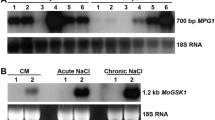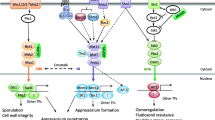Abstract
A gene encoding a mitogen-activated protein kinase (MAPK) putatively orthologous to Pmk1 from Magnaporthe grisea was cloned and characterised from the wheat glume blotch pathogen Stagonospora nodorum. Protein sequence alignments showed the cloned gene, Mak2, is closely related to homologues from other dothideomycete fungi. Expression studies revealed Mak2 is up-regulated during in vitro growth upon nitrogen starvation but is not sensitive to carbon starvation or osmotic stress. Transcript analysis in planta showed Mak2 to be expressed throughout infection and up-regulated during the sporulation phase of the infection cycle. Fungal strains harbouring a disrupted Mak2 gene were created by homologous gene recombination. The mutant strains had a severely altered phenotype in vitro with reduced growth rate and failure to sporulate. Further phenotypic analysis revealed that the mutants had near-normal levels of secreted protease activity, were not hypersensitive to osmotic stress and appeared to have melanin synthesis intact. The mak2 strains were essentially non-pathogenic to wheat leaves. No penetration structures formed and although entry was observed through stomates, the infection rarely continued. The results within this study are discussed within the context of the differences in downstream regulation of the Mak2 MAPK pathway and the cAMP signal transduction pathway in S. nodorum; and differences are compared to mak2 mutant strains in other pathogenic fungi.





Similar content being viewed by others
References
Alspaugh JA, Perfect JR, Heitman J (1997) Cryptococcus neoformans mating and virulence are regulated by the G-protein a subunit GPA1 and cAMP. Genes Dev 11:3206–3217
Altschul SF, Madden TL, Schäffer AA, Zhang J, Zhang Z, Miller W, Lipman DJ (1997) Gapped BLAST and PSI-BLAST: a new generation of protein database search programs. Nucleic Acids Res 25:3389–3402
Benedikz PW, Mappledoram CJ, Scott PR (1981) A laboratory technique for screening cereals for resistance to Septoria nodorum using detached seedling leaves. Trans Br Mycol Soc 77:667–668
Bindschedler LV, Sanchez P, Dunn S, Mikan J, Thangavelu M, Clarkson JM, Cooper RM (2003) Deletion of the SNP1 trypsin protease from Stagonospora nodorum reveals another major protease expressed during infection. Fungal Genet Biol 38:43–53
Bölker M (1998) Sex and crime: heterotrimeric G proteins in fungal mating and pathogenesis. Fungal Genet Biol 25:143–156
Carlile AJ, Bindschedler LV, Bailey AM, Bowyer P, Clarkson JM, Cooper RM (2000) Characterization of SNP1, a cell wall-degrading trypsin, produced during infection by Stagonospora nodorum. Mol Plant Microbe Interact 13:538–550
Davidson RC, Nichols CB, Cox GM, Perfect JR, Heitman J (2003) A MAP kinase cascade omposed of the cell type specific and non-specific elements controls mating and differentiation of the fungal pathogen Cryptococcus neoformans. Mol Microbiol 49:469–485
Di Pietro A, Garcia-Maceira FI, Meglecz E, Roncero MIG (2001) A MAP kinase of the vascular wilt fungus Fusarium oxysporum is essential for root penetration and pathogenesis. Mol Microbiol 39:1140–1152
Dixon KP, Xu JR, Smirnoff N, Talbot NJ (1999) Independent signaling pathways regulate cellular turgor during hyperosmotic stress and appressorium-mediated plant infection by Magnaporthe grisea. Plant Cell 11:2045–2058
Dohlman HG, Thorner J, Caron MG, Lefkowitz RJ (1991) Model systems for the study of seven-transmembrane-segment receptors. Annu Rev Biochem 60:653–688
D’Souza CA, Alspaugh JA, Yue C, Harashima T, Cox GM, Perfect JR, Heitman J (2001) Cyclic AMP-dependent protein kinase controls virulence of the fungal pathogen Cryptococcus neoformans. Mol Cell Biol 21:3179–3191
Gao S, Nuss DL (1996) Distinct roles for two G protein alpha subunits in fungal virulence, morphology, and reproduction revealed by targeted gene disruption. Proc Natl Acad Sci USA 93:14122–14127
Gustin MC, Albertyn J, Alexander M, Davenport K (1998) MAP kinase pathways in the yeast Saccharomyces cerevisiae. Microbiol Mol Biol Rev 62:1264–1300
Jenczmionka NJ, Schaefer W (2005) The Gpmk1 MAP kinase of Fusarium graminearum regulates the induction of specific secreted enzymes. Curr Genet 47:29–36
Jenczmionka NJ, Maier FJ, Losch AP, Schaefer W (2003) Mating, conidiation and pathogenicity of Fusarium graminearum, the main causal agent of the head-blight disease of wheat, are regulated by the MAP kinase gpmk1. Curr Genet 43:87–95
Lev S, Sharon A, Hadar R, Ma H, Horwitz BA (1999) A mitogen-activated protein kinase of the corn leaf pathogen Cochliobolus heterostrophus is involved in conidiation, appressorium formation, and pathogenicity: diverse roles for mitogen-activated protein kinase homologs in foliar pathogens. Proc Natl Acad Sci USA 96:13542–13547
Liu S, Dean RA (1997) G protein alpha subunit genes control growth, development, and pathogenicity of Magnaporthe grisea. Mol Plant Microbe Interact 10:1075–1086
Mayorga ME, Gold SE (1999) A MAP kinase encoded by the ubc3 gene of Ustilago maydis is required for filamentous growth and full virulence. Mol Microbiol 34:485–497
Mey G, Oeser B, Lebrun MH, Tudzynski P (2002) The biotrophic, non-appressorium-forming grass pathogen Claviceps purpurea needs a Fus3/Pmk1 homologous mitogen-activated protein kinase for colonization of rye ovarian tissue. Mol Plant Microbe Interact 15:303–312
Nishimura M, Park G, Xu JR (2003) The G-beta subunit MGB1 is involved in regulating multiple steps of infection-related morphogenesis in Magnaporthe grisea. Mol Microbiol 50:231–243
Ortoneda M, Guarro J, Madrid MP, Caracuel Z, Roncero MIG, Mayayo E, Di Pietro A (2004) Fusarium oxysporum as a multihost model for the genetic dissection of fungal virulence in plants and mammals. Infect Immun 72:1760–1766
Regenfelder E, Speelig T, Hartman A, Lauenstein S, Boelker M, Kahmann R (1997) G proteins in Ustilago maydis: transmission of multiple signals?. EMBO J 16:1934–1942
Solomon PS, Oliver RP (2001) The nitrogen content of the tomato leaf apoplast increases during infection by Cladosporium fulvum. Planta 213:241–249
Solomon PS, Oliver RP (2004) Functional characterisation of glyoxalase I from the fungal wheat pathogen Stagonospora nodorum. Curr Genet 46:115–121
Solomon PS, Tan KC, Oliver RP (2003a) The nutrient supply of pathogenic fungi; a fertile field for study. Mol Plant Pathol 4:203–210
Solomon PS, Thomas SW, Spanu P, Oliver RP (2003b) The utilisation of di/tripeptides by Stagonospora nodorum is dispensible for wheat infection. Physiol Mol Plant Pathol 63:191–199
Solomon PS, Lee RC, Wilson TJG, Oliver RP (2004a) Pathogenicity of Stagonospora nodorum requires malate synthase. Mol Microbiol 53:1065–1073
Solomon PS, Tan KC, Sanchez P, Cooper RM, Oliver RP (2004b) The disruption of a G alpha subunit sheds new light on the pathogenicity of Stagonospora nodorum on wheat. Mol Plant Microbe Interact 17:456–466
Solomon PS, Tan K-C, Oliver RP (2005) Mannitol 1-phosphate metabolism is required for sporulation in planta of the wheat pathogen Stagonospora nodorum. Mol Plant Microbe Interact 18:110–115
Takano Y, Kikuchi T, Kubo Y, Hamer JE, Mise K, Furusawa I (2000) The Colletotrichum lagenarium MAP kinase gene CMK1 regulates diverse aspects of fungal pathogenesis. Mol Plant Microbe Interact 13:374–383
Thompson JD, Higgins DG, Gibson TJ (1994) CLUSTAL W: improving the sensitivity of progressive multiple sequence alignment through sequence weighting, position-specific gap penalties and weight matrix choice. Nucleic Acids Res 22:4673–4680
Urban M, Mott E, Farley T, Hammond-Kosack K (2003) The Fusarium graminearumMAP1gene is essential for pathogenicity and development of perithecia. Mol Plant Pathol 4:347–359
Weber GF (1922) Septoria diseases of wheat. Phytopathology 12:537–585
Xu JR (2000) Map kinases in fungal pathogens. Fungal Genet Biol 31:137–152
Xu JR, Hamer JE (1996) MAP kinase and cAMP signaling regulate infection structure formation and pathogenic growth in the rice blast fungus Magnaporthe grisea. Genes Dev 10:2696–2706
Xu J-R, Staiger CJ, Hamer JE. (1998) Inactivation of the mitogen-activated protein kinase Mps1 from the rice blast fungus prevents penetration of host cells but allows activation of plant defense responses. Proc Natl Acad Sci USA 95:12713–12718
Zheng L, Campbell M, Murphy J, Lam S, Xu JR (2000) The BMP1 gene is essential for pathogenicity in the gray mold fungus Botrytis cinerea. Mol Plant Microbe Interact 13:724–732
Acknowledgement
The authors would like to acknowledge the financial support of the Grains Research and Development Corporation.
Author information
Authors and Affiliations
Corresponding author
Additional information
Communicated by J. Heitman
Rights and permissions
About this article
Cite this article
Solomon, P.S., Waters, O.D.C., Simmonds, J. et al. The Mak2 MAP kinase signal transduction pathway is required for pathogenicity in Stagonospora nodorum. Curr Genet 48, 60–68 (2005). https://doi.org/10.1007/s00294-005-0588-y
Received:
Revised:
Accepted:
Published:
Issue Date:
DOI: https://doi.org/10.1007/s00294-005-0588-y




